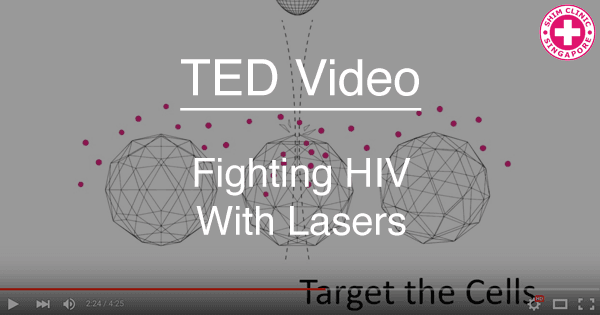In this video TED Fellow Patience Mthunzi talks about innovations in curing HIV using lasers. She delivers a powerful talk about the application of lasers for curing HIV in the near future. She starts her talk by drawing analogies with the mechanism of Asprin and discussing its pros and cons. Aspirin was used as an example for orally delivered drugs. Although taking pills in easy, non-invasive and fast, the drug gets diluted by the time it reaches the target.
The same applies to orally administered HIV drugs including HIV PEP and PrEP provided by STD clinics. They effectively lower the viral count and increase CD4 positive cells, but they get highly diluted by the time they reach HIV viral reservoirs. The main HIV viral reservoirs include areas like lymph nodes, nervous system, lungs etc. Eventually with the administering of drugs, viral particles reduce significantly, but some viral particles still persist albeit in a dormant form. When the medication is discontinued, the virus becomes active again and infects new cells. A major challenge in treating HIV patients with available anti-retroviral drugs is that the drug regime lasts an entire lifetime. Adherence to such regimes is not always followed religiously by patients. In addition, there is always the problem of dilution when taken orally.
Thus, a solution which would directly deliver drugs into the viral reservoir sites would be perfect as it would circumvent the problem of dilution. Mthunzi presents lasers as such a solution. She points out that lasers are being successfully used in several fields of medical science like dentistry, surgeries etc.
In experimental trials, a therapeutic mechanism using lasers has been developed. A very powerful yet small laser beam is directed at the membrane of cells infected with HIV while these cells are immersed in liquid containing drugs. The laser creates small holes in the cell membrane, which allows the cell to absorb the drug. These holes self-repair at a very high speed which prevents any damage to the cell itself. These experiments have been carried out in vitro, however, they can be applied in humans soon.
Mthunzi introduces a 3-headed device designed for applying this therapy in humans. The 3-headed device comprises of a camera, drug sprinkler and a laser. This device would be targeted to the site of infection to create holes. The camera will be instrumental in meandering to the site of infection and finally the drug sprinkler will be used to spray the drug directly at the site of infection. Since the laser has already created an incision at the infection site, the target cell will take up the drug sprayed by the third head. The incision by the laser heals by itself within microseconds with little damage.
This therapeutic technique is infection site-directed and hence highly efficient. This would combine the effectiveness of the anti-retroviral drugs with the localized effect of lasers. It would also avoid side effects and other issues like drug dilution associated with orally delivered drugs and has the potential to bring about a revolution in the field of HIV research. Mthunzi presents her brilliant idea with a lot of enthusiasm and positivity which makes us hopeful of a future for fighting HIV.

